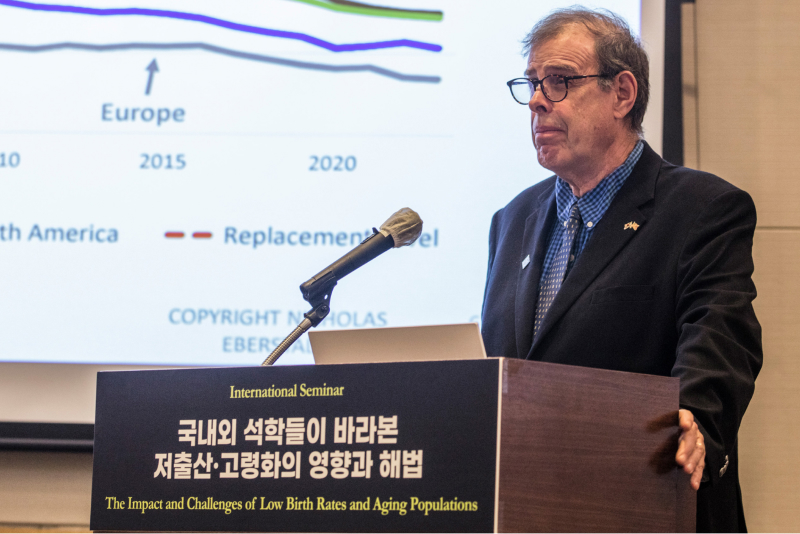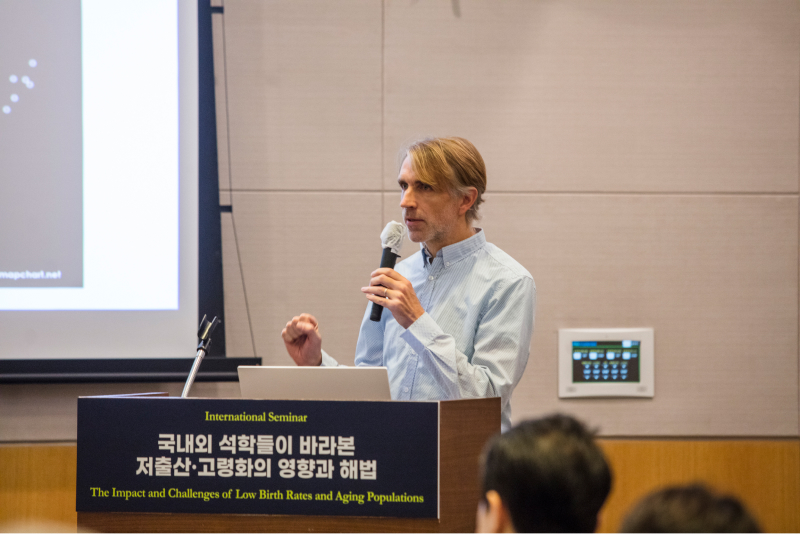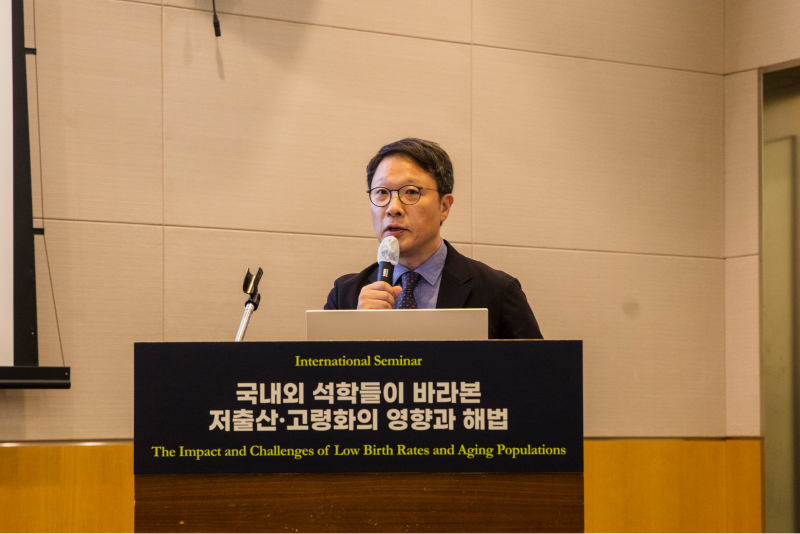in Focus
The Impact and Challenges of Low
Birth Rates and Aging Populations:
Global Scholars’ Perspectives and
Implications for Korea
As of 2023, Korea’s total fertility rate is the lowest in the world at 0.72. To address the country’s low birth rate and aging population, the Korea Economic Research Institute under FKI hosted an international seminar titled “The Impact and Challenges of Low Birth Rates and Aging Population,” inviting renowned scholars from both domestic and international circles.
Photographer Gyu-cheol Shin

Nicholas Eberstadt
- Henry Wendt Chair, American Enterprise Institute (AEI)
- Senior Advisor, National Bureau of Asian Research (NBR)
No one could have foreseen the remarkable economic achievements and progress that South Korea has accomplished today, nor could anyone have anticipated the challenges it currently faces. How should we address the population crisis as we move forward, and what opportunities might it present?
The Global New Normal: Shrinking Populations
Humanity has entered the “age of depopulation.” Birth rates worldwide, led by South Korea, are plummeting at an unprecedented pace, showing little hope of returning to prepandemic levels. The United Nations Development Programme (UNDP) outlines several scenarios concerning global population trends, stating: “Currently, twothirds of the global population resides in regions with belowreplacement fertility rates, and this figure is projected to remain below threequarters.” Low birth rates indicate a shortage of replacement populations, further exacerbating aging trends in the coming decades.
This global population decline will have profound economic repercussions. Therefore, economic policies must go beyond traditional approaches to address this demographic shift, incorporating both microeconomic and macroeconomic perspectives. It is also essential to study how to respond to what may be an enduring decline.
Changing Life Cycles and Challenges from Population Shifts
Demographic economist Ronald D. Lee presented a model illustrating how income and consumption patterns evolve throughout the life cycle. His findings highlight trends in labor and consumption, public versus private spending, and the implications of aging and population decline on societal wealth. Labor income rises sharply in one’s twenties and declines in one’s forties and fifties, influencing patterns of investment and consumption.
These demographic shifts bring numerous challenges. Unlike in the 20th century, there is now a growing focus not only just on material wellbeing but also on achieving genuine human values in areas such as business and the environment. For example, interest in health has surged, and there is an explosive demand for higher education and skill acquisition. Around the world, the number of individuals attaining higher education is increasing exponentially. Attention must also be given to technology. In some regions with sustained population growth, technological advancement has not kept up.
Immigration may also offer a solution. For instance, the United States has provided immense benefits to immigrants over the past 200 years. However, some nations may find it easier to attract talent from abroad and establish new commercial ventures instead. Therefore, immigration must be considered from multiple perspectives, including demographics and politics. Immigration should not be a challenge for migrants but rather a process that facilitates their smooth integration into society and adaptation to their new environment.
Three Issues Stemming from Population Structure Shifts
The future presents three key challenges: The first issue pertains to transitions within lowskill, highpopulation societies. This challenge is already evident in international assessments. Aging populations, coupled with stagnant skill levels, are a common phenomenon globally and are frequently observed in certain countries. The second issue is the rising prevalence of dementia, which poses a massive financial burden. A large proportion of the global population will be aged 80 and older, and this demographic share is steadily increasing. Without medical breakthroughs or clear solutions, dementia will remain a serious problem. The third issue concerns family or relational structures. For example, the burden on eldest children to support their families or the societal impact of family structures shaped by prolonged superlow fertility rates is inevitable. Such shifts have profound implications for society.
Unfortunately, contemporary approaches to population data and family dynamics are often biased. Population counts in the Roman Empire and ancient China were conducted primarily for military or tax purposes. However, understanding how families are structured and how kinship dynamics are evolving is crucial for studying future societal needs and forms of support.
South Korea stands at the forefront of these changes. While the burdens may be significant, Korea is wellpositioned to adapt to demographic transformations and respond effectively.

Stuart Gietel-Basten
- Professor, Hong Kong University of Science and Technology
- Former Consultant, United Nations Population Fund (UNFPA)
South Korea’s low birth rate should not be viewed as a mere “problem” to be solved but rather as a “symptom” signaling the broader failure of the country’s social systems. This perspective invites a reevaluation of Korea’s population policies and suggests alternative ways to address demographic challenges.
Traditionally, population policies have been specific programs implemented by governments to influence demographic trends, originally designed as tools for economic growth. Introduced extensively since the 1970s, these policies were effective in the past but no longer produce the desired results. Despite the introduction of numerous population policies each year, fertility rates continue to decline. Harsh as it may sound, Korea’s population policies—judged solely by total fertility rates—have failed. This calls for a shift in approach. Focusing all policy goals exclusively on demographic changes while ignoring other metrics is far from ideal. Policies such as expanded childcare systems and profamily measures are valuable achievements in and of themselves.
South Korea’s younger generations—often referred to as the “N-po generation”—are giving up not only love, marriage, and childbirth but also other opportunities in life. This stems from systemic failures that prevent individuals from realizing their potential. What if population policies were designed to improve individual lives? The second principle of the 1994 International Conference on Population and Development (ICPD), organized by the UN: “Countries should ensure that all individuals are given the opportunity to maximize of their potential.” This means creating a society where individuals can maximize their human potential.
Applying this principle to South Korea involves shifting the focus away from fears surrounding low birth rates and instead highlighting the remarkable progress achieved by the country over decades. Korea’s cultural and artistic sectors have flourished, built upon a highly educated, skilled population. While Korea’s economic potential is immense, not everyone is able to realize their productivity fully due to factors such as gender inequality, labor market practices, and entrenched social norms. Low fertility rates are not the problem per se but rather a reflection of flawed systems. All sectors of society must work together to empower individuals and couples in fulfilling their aspirations.
Evaluating the success or failure of population policies requires a new perspective. Now, society as a whole must become actively involved, aligning reproduction with broader social goals. This necessitates comprehensive reforms across systems such as healthcare, welfare, pensions, and education. What should be noted here is that modern society and economies are entering a new phase, transitioning to postmodern societies where people place greater value on wellbeing and selfrealization. Recognizing this shift, we must view low birth rates not as a problem to be solved but as a reflection of broader societal challenges. Instead of a purely demographic approach, a socially centered perspective is needed along with a transition from topdown implementation to bottomup solutions.

Tomas Sobotka
- Deputy Director, Vienna Institute of Demography
- Editor-in-Chief, Vienna Yearbook of Population Research (VYPR)
Low fertility is becoming a global “new normal.” Focusing especially on East Asia’s ultralow fertility, we can identify the main drivers and longterm consequences of this phenomenon.
In East Asia, particularly in major metropolitan areas, ultralow fertility, with total fertility around 1.0 or lower, is especially widespread. This trend has been progressing hand in hand with the rising age at first childbirth. As individuals take longer to complete their education, secure decent employment, and save money, the age at which they form partnerships and have children continues to rise. Many people spend their young adults living single or with their parents, without having an intimate partner.
Some women delay motherhood to the point when they can no longer conceive or bear pregnancy to term. The proportion of women without children by the age of 35 is steadily rising; in South Korea, Japan, Taiwan, and Spain more than four out of ten women aged 35 are childless. Many of them plan to have a child in the future, but infertility, health issues, or lack of suitable partner makes these plans increasingly difficult to realise.
Younger generations increasingly express no desire to start a family or are undecided about their reproductive plans. Many couples choose to remain childless, whereas in the past having children during one’s reproductive years was the norm. Planning to have a child has become increasingly an optional decision, depending on individual circumstances, aspirations and partnership situation. Today, more people consider whether to have children or not based on expected future conditions and policies rather than societal expectations and norms.
In all regions, especially in East Asia, marriage and childbirth are no longer seen as mustdo goals for younger generations. In fact, many feel that they cannot afford to consider these options due to concerns about the future, economic inequality, competitive pressures, and limited upward mobility. Young adults in South Korea and many rich countries today today are the first postwar generation that do not expect to achieve better living standards than their parents have enjoyed.
There will be huge regional variations in population dynamics, with many peripheral and rural areas facing huge challenges and infrastructure adjustments due to rapidly shrinking populations. Population decline will be inevitable in countries that do not experience substantial immigration.
What policies should be implemented to address these challenges? There is neither a single “cureall” solution for low fertility and aging, nor a manual that provides definitive answers that could be used in every society. Governments must adopt a holistic approach, carefully balancing various strategies. Like in climate change policies, both “mitigation policies” and “adaptation strategies” are needed. Familyfriendly policies will be expanded, potentially propping up birth rates. At the same time, radical restructuring of the labour market, health and social policies, education system and migration policies are needed to successfully deal with the challenges posed by ageing and shrinking populations with vanishing younger labour force. Only by combining many different approaches can we improve individual wellbeing and effectively accommodate our societies to these major demographic shifts.

Chul-hee Lee
- Professor, Department of Economics, Seoul National University
- Director of Population Cluster, Institute for Future Strategy, Seoul National University
How will population decline and aging impact South Korea’s industries and potential growth rate? Through an analysis of the domestic labor market, this article examines the future of South Korea’s labor landscape and explores ways to address labor supply and demand imbalances.
South Korea is experiencing rapid aging and population decline, leading to a significant reduction in its workingage population (ages 15–64). However, the workingage population does not directly equate to the actual labor force; hence the need for a more precise projection of labor supply and productivity changes.
So far, projections have assumed that South Korea’s labor force participation rate and productivity would remain stable, but these indicators are likely to improve. Taking this into account, the following five scenarios can be envisioned: First, the labor force participation rate for women increases to Japan’s 2022 level within the next 25 years. Second, the labor force participation rate for men in their 50s to early 60s rises to Japan’s recent levels by 2023. Third, workforce productivity improves, cutting the current rate of productivity decline by half. Fourth, the relative productivity of women reaches the most recent OECD average. Lastly, the labor force participation rate for youth increases to Japan’s recent levels. If all five scenarios materialize, South Korea’s labor input is projected to increase to 109% of the current level over the next 25 years.
These projections suggest that South Korea’s labor force may not shrink significantly despite a declining workingage population. The future of the labor market remains undecided, contingent on how productivity is enhanced and how participation rates are improved.
Even if the total labor supply is sufficient, however, there is risk of severe mismatches in labor supply and demand across industries, occupations, and demographics. By 2032, the industries expected to face the most critical labor shortages nationwide include healthcare and social welfare services (approximately 490,000 workers short), accommodations and food services (around 250,000 workers short), and information and communications technology (roughly 160,000 workers short). Regionally, hitech sectors such as information and communications technology and scientific and technical services are expected to experience labor shortages in Seoul and surrounding metropolitan areas. Meanwhile, in the southeastern region including Ulsan, largescale labor shortages are anticipated across the manufacturing sector.
To address labor market imbalances, strategic and tailored population policies must be implemented considering the unique industrial and labor market characteristics of each region. Ultimately, South Korea must build a society that values individuals, adapts to their needs, provides opportunities, and protects its people. Only then can the potential of every individual be fully utilized without being wasted.
Summary of Panel Discussion in the International Seminar on “The Impact and Challenges of Low Birth Rates and Aging Populations: Global Scholars’ Perspectives and Implications for Korea”
-
1
Addressing population issues requires a holistic approach instead of tackling individual issues in isolation, necessitating a paradigm shift across society. -
2
Declining birth rates are not merely economic problems but structural phenomena driven by changes in social structures and cultural expectations. Therefore, fundamental shifts in labor markets, housing conditions, and education systems are essential. -
3
An inclusive society must be created where individuals have guaranteed access to diverse opportunities, enabling them to reach their full potential.

Dr. Chul Chung (CRO of the Federation of Korean Industries and President of the Korea Economic Research Institute)
Recently, Korea declared a national emergency regarding the population crisis. Given the wideranging social and economic issues that could be brought about by low birth rates, I believe that we all need to pay attention to the low birthrate and think about possible solutions. Unlike the 1997 Asian financial crisis or the 2008 global financial crisis, however, there seems to be a lack of urgency and national consensus regarding this challenge.
It may be necessary to address the decline in labor force and purchasing power due to the population crisis, as well as the need for a shift in social attitudes towards nonmarital births. In addition to policies aimed at increasing the birthrate, urgent measures must be taken, including strategies to boost productivity across the economy and the development of a society that embraces diversity.

Dr. In-sill Yi (President, Korean Peninsula Population Institute for Future)
Korea has historically been a fast follower, quickly joining the ranks of advanced nations and leaving its mark on global economic history. Going forward, we must become a first mover in addressing population issues and set an example for the world. We should seize the current population challenges as an opportunity to transform societal structures, such as achieving gender equality. Creating the necessary systems for this transformation is critical. Companies must take the lead in creating environments where everyone can work.

Dr. Jai-Joon Hur (President, Korea Labor Institute)
Factors negatively affecting the fertility rate include 1) the difficulty for women to maintain their careers after having children, 2) the tendency for young adults to postpone or abandon family formation due to job insecurity and pessimistic prospects for income growth, and 3) the fact that Korean women perform far more domestic work than women in other countries. Greater flexibility in working hours during childrearing period, improving young people’s positive perceptions of their job and income prospects, and more active participation of men in domestic work will help to reverse the declining fertility rate.

Bernard Hoekman (Professor, European University Institute)
Korea exhibits outlier characteristics in various dimensions, including demographics. If current policies are proving to be ineffective, it is essential to adopt a fresh, comprehensive approach that incorporates multiple factors. A systematic, topdown approach could be beneficial. Considering Korea’s traditional focus on manufacturing and goodsbased industries, it might be worthwhile to leverage trade and services to address demographic challenges.
